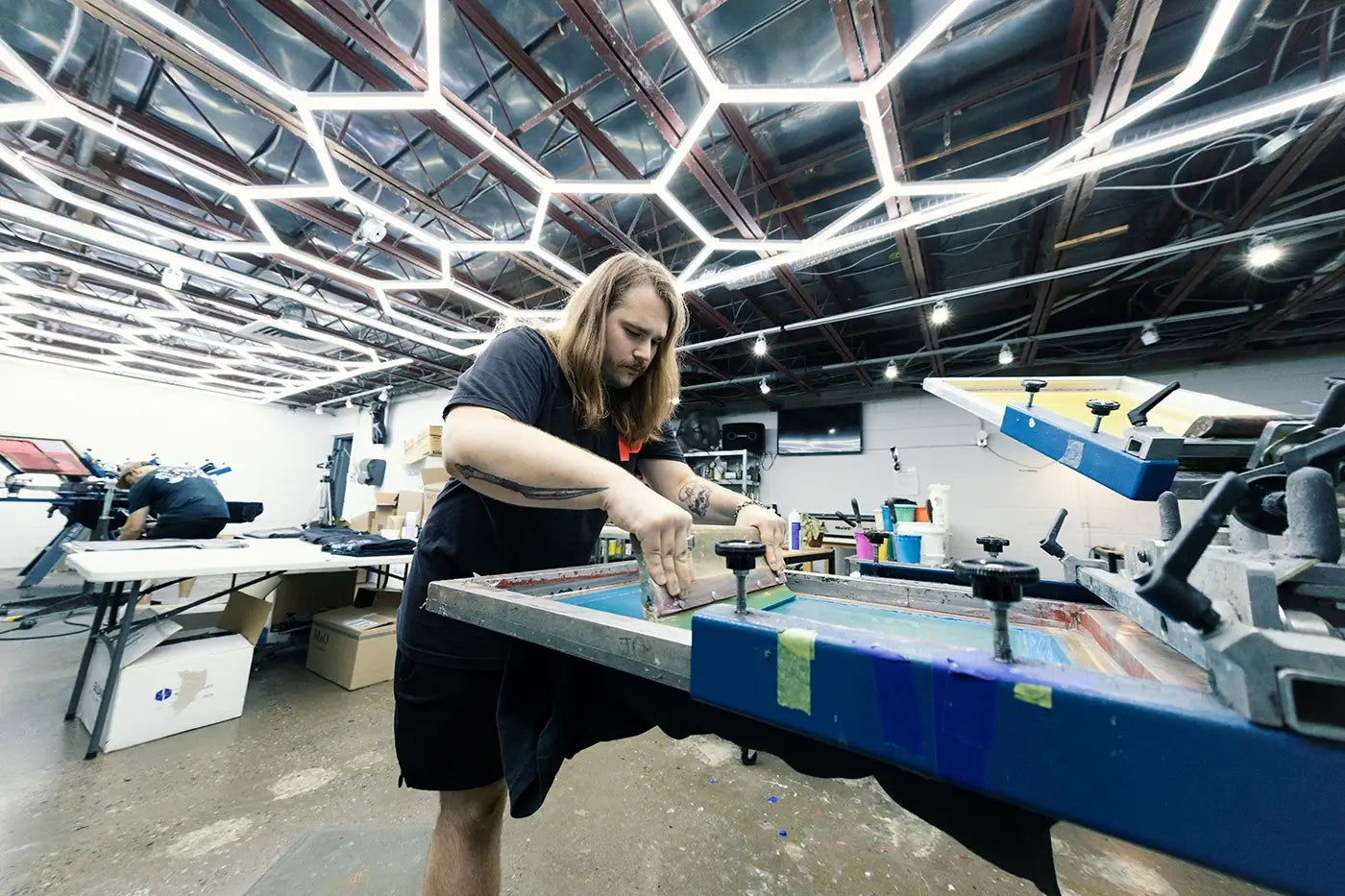Professional Screen Printing Kit for Custom Apparel
Professional Screen Printing Kit for Custom Apparel
Blog Article
Screen Printing Uncovered: Everything You Need to Understand About Tee Shirt and Garment Printing Strategies
Display printing is an interesting approach that incorporates art with method, providing endless possibilities for creativity. All set to explore the vital elements that make display printing an art type?
The Basics of Display Printing: How It Functions
When you plunge into screen printing, you'll find it's both an art and a science. At its core, screen printing includes developing a stencil, or screen, that allows ink to go through only in specific areas (screen printing kit). You start by picking your design and preparing your display with a light-sensitive emulsion. Once you expose this solution to light, it hardens, leaving your style as a negative room.
Placement the display over the fabric, then make use of a squeegee to push ink with the display onto the garment. Each action is important, and grasping them will certainly boost your display printing skills, transforming easy garments right into one-of-a-kind, expressive pieces.
Types of Display Printing Strategies
As soon as you grasp the basics of display printing, it's time to check out the different methods that can raise your designs. One preferred approach is standard screen printing, where ink is pushed via a stenciled screen.
Another alternative is plastisol printing, known for its sturdiness and vibrant colors, making it a favored for numerous brands. Experiment with halftone printing to create gradient impacts and intricate designs.
Important Equipment for Screen Printing
To accomplish magnificent outcomes in display printing, having the right devices is essential. You'll require a durable display printing structure, which holds the mesh that moves your layout onto the garment. Next off, invest in top notch mops; these are vital for applying ink evenly across the screen.
Choosing the Right Inks and Products
When choosing inks and products for display printing, you require to think about the type of ink that works ideal for your task. Consider textile compatibility to ensure your styles look last and fantastic long. Also, explore environmentally friendly ink alternatives to make your printing process more lasting.
Types of Display Inks
Selecting the best display ink is necessary for accomplishing vibrant, sturdy prints that satisfy your project's demands. There are a number of sorts of display inks to analyze. Plastisol ink is popular for its convenience and simplicity of usage, offering superb color opacity on dark textiles. Water-based ink, on the other hand, supplies a softer feel and is eco-friendly, making it suitable for those wanting to decrease their environmental effect. Discharge inks eliminate color from the fabric, causing a soft, vintage appearance but call for specific handling. Specialty inks, such as glow-in-the-dark or metallic, can add unique impacts to your layouts. Evaluate your job needs and select the ink that aligns finest with your wanted outcome.

Fabric Compatibility Considerations
Comprehending fabric compatibility is essential for achieving top notch screen prints, especially since various products react distinctly to various inks. Constantly examine your inks on sample material to assure they adhere properly and preserve shade integrity. Furthermore, maintain in mind that fabric weight and structure can influence the final result, so picking the best ink and product combo is crucial for your project's success.
Eco-Friendly Ink Options
Environmentally friendly inks are ending up being a preferred selection for display printers that desire to decrease their environmental effect while maintaining high quality. When choosing inks, think about water-based inks, which are less hazardous and simpler to clean up compared to typical solvents.
In addition, seek inks made from eco-friendly sources, such as soy or vegetable-based choices. By selecting the best inks and products, you'll not just develop stunning styles yet likewise add to a more sustainable printing process. Make the button, and your prints will reflect your dedication to the setting!
Preparing Your Layout for Screen Printing

File Layout Demands
To guarantee your design looks sharp and vivid on textile, you'll require to pay very close attention to file style t-shirt printing requirements for display printing. Beginning with vector files like AI or EPS, as they can be scaled without losing high quality. If you make use of raster images, go with high-resolution documents, such as TIFF or PNG, ideally at 300 DPI. Prevent making use of JPEGs, as they can shed clearness when resized. Make sure your style has a transparent history to protect against undesirable white edges on your prints. Ultimately, keep color modes in mind; CMYK is typical for screen printing, so convert your RGB develops appropriately. By following these guidelines, you'll set your art work up for an effective print.
Color Separation Techniques
Color separation is a vital step in preparing your design for screen printing, and mastering it can significantly enhance your print high quality. You'll need to break your design into private shades, as each shade requires a different display during printing. Start by recognizing all the shades in your style and create layers each. You can make use of software application like Adobe Photoshop or Illustrator to separate and separate shades effectively. Be certain to conserve each layer as a different data, usually in a style like TIFF or PSD. This precision not just guarantees exact shade representation yet additionally improves the printing process. By taking notice of color splitting up, you'll accomplish expert and vibrant lead to your screen-printed garments.
Resolution and Size
Attaining the very best lead to display printing begins with ensuring your style has the right resolution and size. Preferably, your art work ought to go to least 300 DPI (dots per inch) for sharp, clear prints. Your last product may look unprofessional and pixelated. if you utilize reduced resolution.
When it concerns dimension, think about the measurements of your print area. Style your art work to match the final print size, ideally producing it in the real measurements you'll be printing. In this manner, you'll prevent any kind of unexpected scaling issues.
Always inspect your style in both vector and raster layouts. Vector graphics can be scaled without shedding top quality, making them suitable for display printing. Preparing appropriately will ensure your style looks amazing on every garment!
Step-by-Step Screen Printing Process
Display printing is a vibrant procedure that permits you to develop vivid layouts on numerous surface areas. To obtain begun, you'll need a screen, solution, and your selected ink.
After washing out the unexposed emulsion, your display prepares. Set it up on your printing surface and straighten your garment underneath it. Put ink onto the screen and use a squeegee to press the ink with the stencil onto the fabric. Lift the screen carefully and allow the print dry. Heal the ink using warm to guarantee toughness. That's it! You've efficiently screen printed your style.
Tips for Successful Display Printing Projects
While you're diving into your display printing projects, keep in mind that preparation is key to success. Begin by gathering all your products-- inks, displays, squeegees, and garments. A clean work space helps prevent undesirable mistakes, so clean up prior to you begin.
Following, confirm your art work is high-resolution and appropriately sized for your garment. Evaluate your screen for correct direct exposure and clean it completely to prevent smudges. When mixing your inks, comply with the manufacturer's standards to attain the appropriate consistency.
Throughout printing, use also stress with your squeegee for consistent results. Don't rush; take your time to validate each print fulfills your requirements. After printing, allow your garments completely dry completely before taking care of or packaging them.
Lastly, always maintain an example of your job for future reference. This method, you can analyze your progress and improve your strategies gradually. Satisfied printing!

Frequently Asked Inquiries
How much time Does It Require To Establish a Display Printing Task?
Setting up a display printing work commonly takes around 30 minutes to an hour. You'll prepare the screens, mix inks, and adjust journalism. The time varies based upon intricacy and experience, so stay organized!
Can I Publish on Various Material Types Making Use Of the Exact Same Method?
Yes, you can print on various material types using the very same method, however you'll need to readjust your settings and inks. Some fabrics absorb ink differently, so experimenting warranties the very best results for each material.
What Prevail Mistakes to Prevent in Screen Printing?
When display printing, stay clear of typical blunders like using the incorrect ink, neglecting correct exposure times, or missing pre-press checks. Always examine your arrangement and keep tidy displays to assure high quality results each time.
How Can I Properly Clean and Maintain My Display Printing Tools?
To properly clean and preserve your display printing devices, you must routinely wash displays with ideal solvents, inspect mops for wear, and assure all devices are stored dry and dust-free. Uniformity prevents pricey repair work and boosts efficiency.
Is Display Printing Eco-friendly Compared to Various Other Methods?
Screen printing can be much more environmentally pleasant than other methods, particularly if you use eco-conscious materials and water-based inks. By picking sustainable materials and methods, you lower waste and reduce your effect on the world.
Display Printing Uncovered: Every Little Thing You Need to Know About Tee and Garment Printing Techniques
At its core, screen printing involves producing a pattern, or screen, that allows ink to pass via just in specific locations. Position the screen over the textile, after that make use of a squeegee to push ink through the screen onto the garment. One popular method is conventional screen printing, where ink is pushed with a stenciled screen.When selecting inks and materials for screen printing, you need to take into account the type of ink that works finest for your job.
Report this page